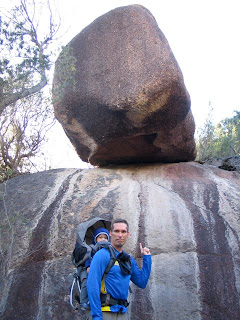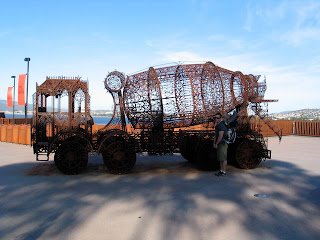The end of Thursday March 28 marked the celebration of the first of four school terms done. Good Friday and Saturday were spent getting the house chores done and packing up for our two week trip to Tasmania! This is a summary of what we saw.
You will notice
that in many of our pictures, we are wearing toques, fleece jackets, and long
pants. Heather sported some impressive looking leg warmers too! The temperatures are much colder here. It was embarrassing to be so soft
when it cam to temperatures of only 15 C. We felt so uncomfortably cold, and
hated the fact that other Aussies would see us Canadians dressed up so warm.
March 21 marked the first day of autumn here and although there are few
deciduous trees in Tasmania, the “feel” of fall is similar to that of Edmonton.
As we drove along the Tasmanian highway to Port Arthur, many of the trees had
been burnt by the fires and so it looked like our autumn trees after the leaves
had fallen.
Port Arthur is the
site of one of the largest original penal colonies build by the British. The
buildings are broken but are being restored. It is hard to describe the
emotions when you visit a site like this. It is similar to visiting prisoner
camps in Germany.
Once we had had our
fill of Port Arthur, we drove to the Tasman peninsula to a place called
Eaglehawk neck. Here they have special rocks that have fractured and eroded to
look like tiles – known as Tessellated pavement. Along the coast, you can see
other beautiful erosional features such as Devils kitchen and the Tasman Arch.
In order to get
more Tasman penal history and experience even more natural beauty, we decided
to go to Triabunna, a lovely little town with a ferry that could take us to
Maria Island.
There are no vehicles on this island, so most people rent
bicycles to get around or go on multiple day hikes. We decided to go to the
island for a day (with Fenton on my back) and try to do as much walking around
as possible. Although we could not see the entire island, we did get to witness
the Painted cliffs, Darlington penitentiary ruins, fossil cliffs, and even a
wombat!
Our next
destination was Freycinet National Park. There are many long hikes there, but
Fenton insisted that we only do a couple of short ones. We decided on Wine
Glass bay and Coles bay, two rather steep walks that gave daddy a good workout
and the reward of breathtaking views.
Bicheno, our next
stop is a lovely little fishing town. We hired a glass bottom boat to check out
all of the sea life in the harbor. We learned a lot about the different kinds
of fish, algae, and seaweed. There were even some bioluminescent insects that
gave us a light show. We made one last stop at the blowhole and then off to our
campsite.
We met a couple
from New Zealand who highly recommended going north to Saint Helens to see the
Bay of Fires and Binalong Bay. So the next day we were off to see rocks painted
a vibrant red colour by the local algae. There were actually many different
coloured species of algae there, ranging from white to yellow, green, red and even
purple. A beautiful place.
Our next stop was
Launceston, the “other city” in Tasmania. It is a very nice place with what I
think may be one of the most spectacular running paths I’ve seen. The city
built a series of trails along the Cataract Gorge complete with suspension
bridges – absolutely stunning.
Next day we
continued up north to Narawntapu National Park for some more hiking and a
picnic in the historic Yorktown.
To get to the east
side of the inlet (the Georgetown side) we crossed the “Batman Bride”. Why it
was named this, we can’t figure out. They could have at least shaped it like
the batman symbol or something. We stopped at Beauty Point to see the platypus
house – we just had no luck seeing any in the wild. Apparently, the platypus is
easiest to find in Tasmania because they are not nocturnal, unlike the rest of
Australia. We stopped in at Deloraine to see the wonderful Liffey Falls.
Mole Creek is a
small town in the mid north west of Tasmania. Here you can see two rather
different cave systems – Marakoopa and King Solomons caves. The first was much
larger than the other, but they both had stunning rock formations to look at
and tight spaces to fit Fenton through. Who said traveling with children wasn’t
fun?
After an overnight
stay in Burnie, we drove to the old town of Zeehan. The buildings are very old
and rustic here, and it felt like we were transformed back in time. We visited
a very old cemetery, affectionately named the pioneers cemetery. The grave
sites were very old and most were overgrown with vegetation. It was very sad to
see these sites being allowed to deteriorate.
The next day we visited the town of Strahan.
It was a great place to stay, but quite expensive. The town has really catered
to tourists by having loads of places to stay, cruises, walks, etc. We decided
to do a few walks, one in particular being the beautiful Hogarth Falls.
The next day we
drove through the bleak and dreary Queenstown. This was the site of a big
copper mine and the devastation was quite apparent.
Finally, we returned to Hobart, but decided to take the ferry to Bruny
Island and stay the night. We were very lucky to see the white wallabies, a
species that is only found on this island. When we returned to Hobart the next day, we drove up to the top of Mt. Wellington, checked out the wharf, checked out the markets at Salamanca place, and visited the famous Museum of Old and New Art (MONA)































































